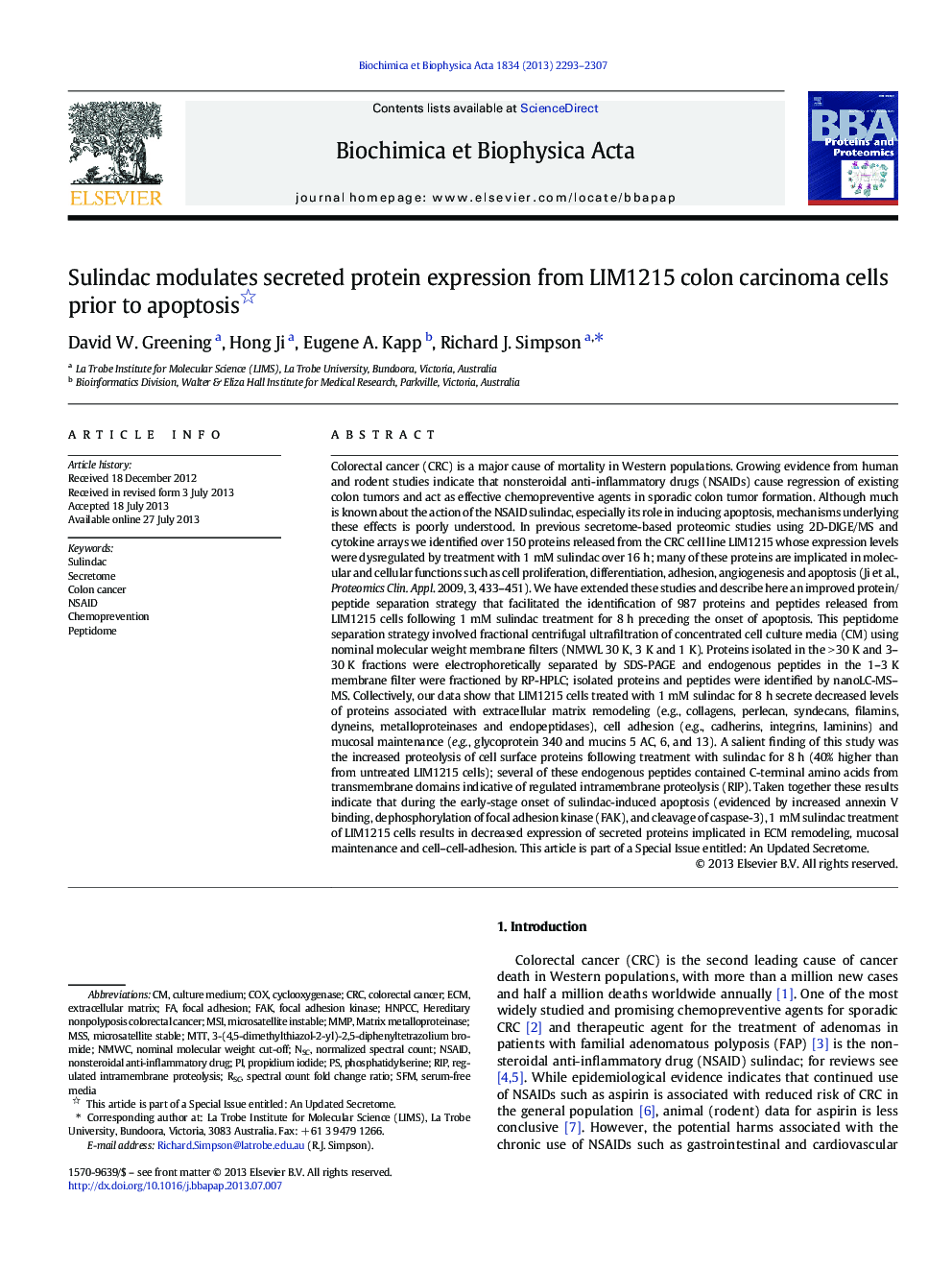| کد مقاله | کد نشریه | سال انتشار | مقاله انگلیسی | نسخه تمام متن |
|---|---|---|---|---|
| 1178462 | 962694 | 2013 | 15 صفحه PDF | دانلود رایگان |

• Understand events associated with early-onset stage of apoptosis.
• Develop protein (bottom-up proteomic) separation strategy to characterise secretome.
• Develop top-down approach to characterise low-Mr secreted polypeptides.
• Demonstrate increased proteolysis of cell surface (ectodomain) proteins.
• Secreted proteins implicated in mucosal maintenance and cell-cell-adhesion.
• Contribute to extracellular modulators of apoptosis and chemoprevention.
Colorectal cancer (CRC) is a major cause of mortality in Western populations. Growing evidence from human and rodent studies indicate that nonsteroidal anti-inflammatory drugs (NSAIDs) cause regression of existing colon tumors and act as effective chemopreventive agents in sporadic colon tumor formation. Although much is known about the action of the NSAID sulindac, especially its role in inducing apoptosis, mechanisms underlying these effects is poorly understood. In previous secretome-based proteomic studies using 2D-DIGE/MS and cytokine arrays we identified over 150 proteins released from the CRC cell line LIM1215 whose expression levels were dysregulated by treatment with 1 mM sulindac over 16 h; many of these proteins are implicated in molecular and cellular functions such as cell proliferation, differentiation, adhesion, angiogenesis and apoptosis (Ji et al., Proteomics Clin. Appl. 2009, 3, 433–451). We have extended these studies and describe here an improved protein/peptide separation strategy that facilitated the identification of 987 proteins and peptides released from LIM1215 cells following 1 mM sulindac treatment for 8 h preceding the onset of apoptosis. This peptidome separation strategy involved fractional centrifugal ultrafiltration of concentrated cell culture media (CM) using nominal molecular weight membrane filters (NMWL 30 K, 3 K and 1 K). Proteins isolated in the > 30 K and 3–30 K fractions were electrophoretically separated by SDS-PAGE and endogenous peptides in the 1–3 K membrane filter were fractioned by RP-HPLC; isolated proteins and peptides were identified by nanoLC-MS–MS. Collectively, our data show that LIM1215 cells treated with 1 mM sulindac for 8 h secrete decreased levels of proteins associated with extracellular matrix remodeling (e.g., collagens, perlecan, syndecans, filamins, dyneins, metalloproteinases and endopeptidases), cell adhesion (e.g., cadherins, integrins, laminins) and mucosal maintenance (e.g., glycoprotein 340 and mucins 5 AC, 6, and 13). A salient finding of this study was the increased proteolysis of cell surface proteins following treatment with sulindac for 8 h (40% higher than from untreated LIM1215 cells); several of these endogenous peptides contained C-terminal amino acids from transmembrane domains indicative of regulated intramembrane proteolysis (RIP). Taken together these results indicate that during the early-stage onset of sulindac-induced apoptosis (evidenced by increased annexin V binding, dephosphorylation of focal adhesion kinase (FAK), and cleavage of caspase-3), 1 mM sulindac treatment of LIM1215 cells results in decreased expression of secreted proteins implicated in ECM remodeling, mucosal maintenance and cell–cell-adhesion. This article is part of a Special Issue entitled: An Updated Secretome.
Journal: Biochimica et Biophysica Acta (BBA) - Proteins and Proteomics - Volume 1834, Issue 11, November 2013, Pages 2293–2307